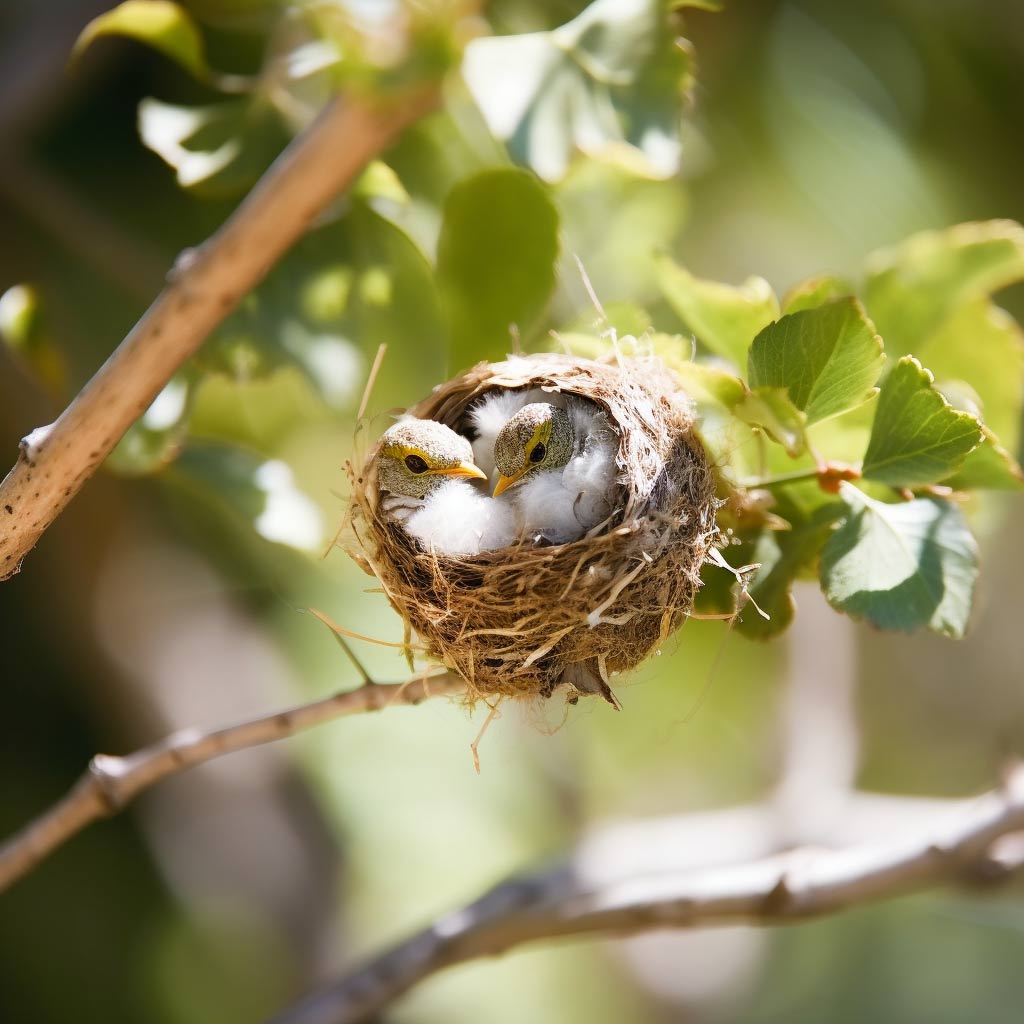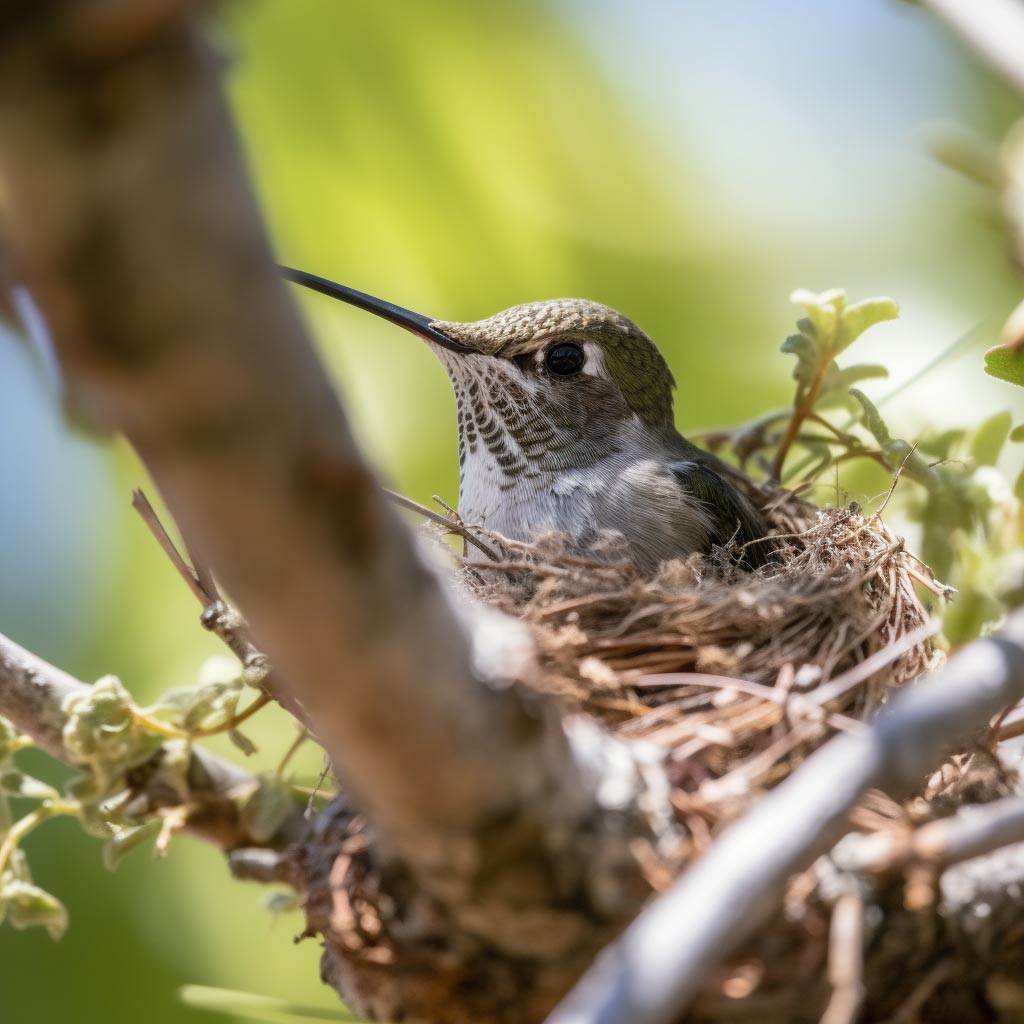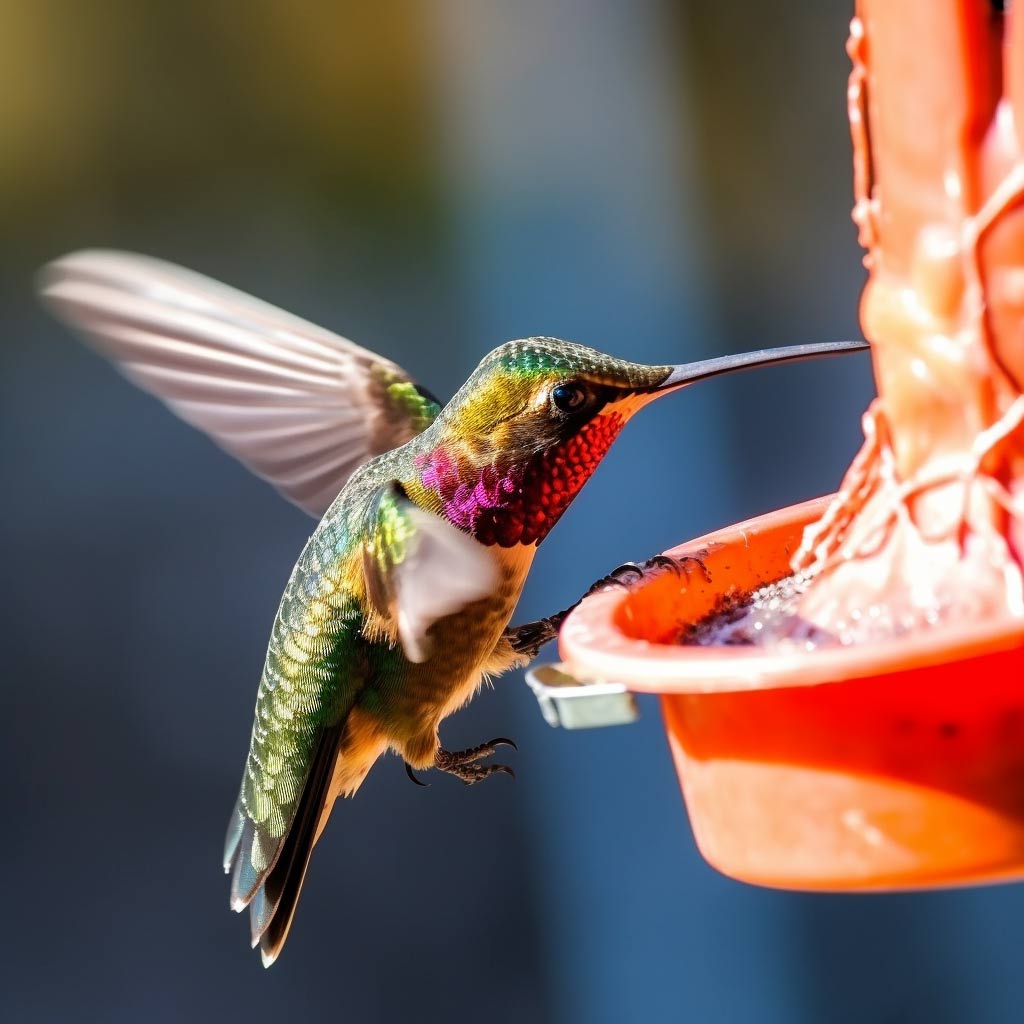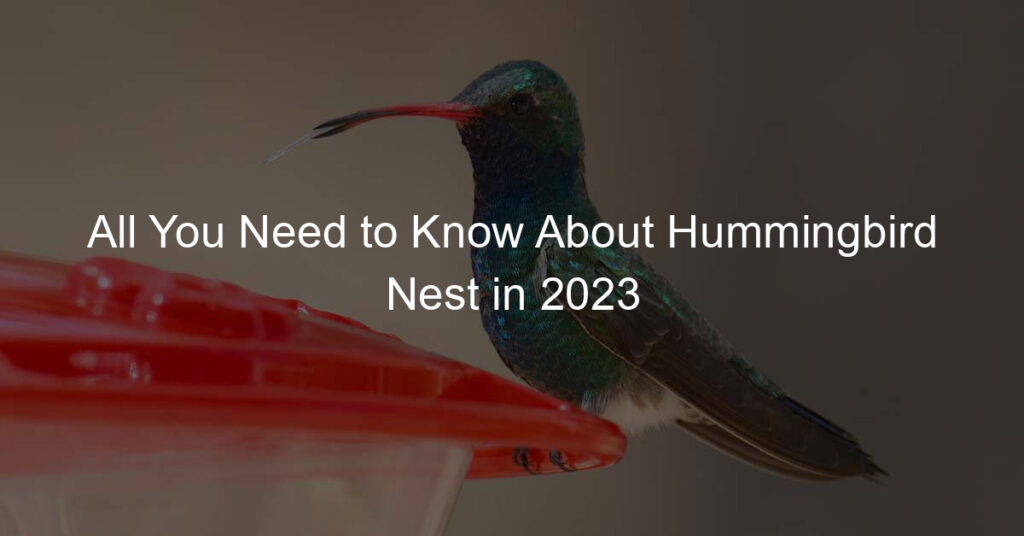Have you ever marveled at the beauty and grace of hummingbirds, those tiny, colorful creatures that seem to defy the laws of physics with their incredible aerial acrobatics? If so, you’ll be thrilled to discover another astonishing aspect of these remarkable birds: their intricate and cleverly designed hummingbird nest. In this blog post, we’ll explore the fascinating world of hummingbird nesting, from the unique construction materials to the distinctive nesting habits of various species, and even how you can attract these enchanting birds to your own backyard.
So, get ready to embark on an exciting journey into the world of hummingbird nests, a place where engineering marvels meet the natural world, and where the smallest of birds create the most exquisite and awe-inspiring homes for their precious eggs and chicks.
Short Summary
- Marvel at the tiny, perfectly camouflaged hummingbird nests!
- Provide food sources, shelter & nesting materials to attract them to your yard.
- Get excited and support their conservation with kits & identification guides!
The Marvel of Hummingbird Nests

Hummingbird nests are truly a wonder of nature, with their minuscule size, perfect camouflage, and ingenious use of materials. These tiny birds create some of the most beautiful and delicate nests in the world, tailored to their specific needs and preferences. Imagine a nest so small that it could comfortably sit on top of a ping pong ball, yet capable of keeping fragile eggs and chicks safe from predators and the elements.
What’s even more impressive is the variety of materials that hummingbirds use for their nest construction. From soft plant fibers and spider silk to lichen and moss, these resourceful birds combine a range of natural materials to create nests that are not only functional but also visually stunning.
Let’s dive deeper into the fascinating world of hummingbird nests by exploring their size and camouflage, nesting materials, and differences among species.
Size and Camouflage
The size of a hummingbird nest is nothing short of amazing, with most nests measuring just a little over one inch in diameter. These tiny nests are typically located high up in trees or shrubs, with some species choosing to build their nests 10 to 40 feet above the ground. The female hummingbird is responsible for constructing the nest, which is usually built in a forked branch or in dense shrubs, providing both support and protection.
Camouflage plays a crucial role in the survival of hummingbird chicks, as the nests are often well-hidden among shrubs, bushes, or leafy branches of trees. Mother hummingbirds go to great lengths to ensure their nests blend seamlessly with their surroundings, even using bits of lichen or moss to decorate the nest’s exterior. This clever camouflage helps protect delicate eggs and chicks from predators, as well as curious humans who might unwittingly disturb the nest.
Nesting Materials
The choice of nesting materials is essential for the success of a hummingbird nest. Female hummingbirds collect a variety of soft and flexible natural materials, such as twigs, leaves, moss, and lichen, to create a strong yet flexible structure for their nest. One of the most remarkable materials used in nest construction is spider silk, which serves as threads to bind the nest together and attach it to the supporting branches.
The use of spider silk in hummingbird nest construction offers several benefits. Not only does it provide strength and elasticity to the nest, but it also allows for easy attachment of other materials for camouflage. In addition, the use of plant fibers for the nest’s floor creates a soft, spongy, and flexible surface, which allows the nest to expand as the chicks grow. This adaptability is crucial for the survival and comfort of the growing chicks.
Species Differences
While all hummingbird nests share some common characteristics, there are notable differences among various species in terms of nesting habits and preferences. For example, some species, such as the ruby-throated hummingbird, prefer to build their nests in deciduous trees, while others might choose pine trees or thorny bushes as their preferred nesting locations.
These differences in nesting habits can be attributed to the specific needs and requirements of each hummingbird species. Some species may prefer certain types of trees or shrubs for their nests due to the availability of food sources nearby, while others may choose specific locations for better protection from predators or the elements.
By understanding the nesting habits of different hummingbird species, we can better appreciate the incredible diversity and adaptability of these tiny birds.
The Nesting Cycle

The life cycle of a hummingbird nest is a fascinating process that involves several stages, from mating and territory establishment to egg incubation, fledging, and survival. Each stage in the nesting cycle plays a crucial role in the overall success of the nest and the survival of the chicks.
In this section, we will delve into the various stages of the nesting cycle, providing you with a comprehensive understanding of the complex and fascinating world of hummingbird reproduction. From the elaborate mating rituals to the tender care of the chicks, the nesting cycle offers a glimpse into the incredible resilience and adaptability of these tiny birds.
Mating and Territory
The mating season for hummingbirds typically begins in mid to late March, with males engaging in a variety of acrobatic displays to attract a female mate. These displays may include deep dives, zigzag flying, and other aerial feats that showcase their strength, agility, and grace.
Once a female hummingbird has chosen her mate, the actual mating process is quite brief, lasting no more than a few seconds. Interestingly, male hummingbirds do not possess an external penis, and instead, the male simply presses his posterior opening or cloaca against the female’s, transferring sperm to fertilize the eggs.
Following mating, the female hummingbird is solely responsible for building the nest, incubating the eggs, and caring for the chicks.
Egg Incubation
After constructing her nest, the female hummingbird lays her eggs, which are typically small and white. Most hummingbird species lay two eggs at a time, although some may lay as many as three. The mother hummingbird then begins the incubation process, during which she sits on the eggs to keep them warm and protected.
The incubation schedule of female hummingbirds is quite remarkable, with the mother bird spending around 50 minutes of each hour incubating the eggs, and only leaving for about 10 minutes to feed herself. This dedication to her eggs ensures their safety and proper development, and after a period of 14 to 23 days, depending on the species, the eggs hatch into tiny, helpless chicks.
Fledging and Survival
Once the chicks hatch, the mother hummingbird continues to care for them, providing food and protection as they grow. The chicks begin exercising their wings at around two weeks of age, and by the time they are three weeks old, they are ready to leave the nest and embark on their own life journey.
Migratory species of hummingbirds, like the ruby-throated hummingbird, start their epic journey southward after they breed in North America. They travel to Central America or Mexico for the winter months. These young birds must learn to navigate and survive in a world full of challenges and dangers, and their success is a testament to the incredible resilience and adaptability of these tiny creatures.
Attracting Hummingbirds to Your Yard

Attracting hummingbirds to nest in your yard is a rewarding and enjoyable endeavor that allows you to witness the marvels of hummingbird nesting up close. To create a welcoming environment for these tiny birds, you need to provide them with food sources, shelter, and nesting materials, while also minimizing disturbance.
In this section, we will explore the various ways in which you can attract hummingbirds to your yard and support their nesting efforts. From planting nectar-rich flowers and maintaining feeders to providing the ideal nesting materials and locations, you can play an active role in supporting these beautiful creatures and ensuring their continued survival in the wild.
Providing Food Sources
One of the most important factors in attracting hummingbirds to your yard is providing them with a reliable food source. Hummingbirds primarily feed on nectar from flowers, which provides them with the energy they need for their high metabolism. To create a hummingbird-friendly garden, plant native flowering plants that produce nectar, such as trumpet vine, bee balm, and red hot poker.
In addition to nectar-producing plants, another way to provide food for hummingbirds is by maintaining hummingbird feeders filled with sugar water. This supplemental food source can be especially valuable during times when natural nectar sources are scarce, such as during droughts or seasonal changes. Be sure to clean and refill your feeders regularly to keep the sugar water fresh and free of harmful bacteria.
Shelter and Nesting Materials
Providing suitable shelter and nesting materials is another key component in attracting hummingbirds to your yard. Hummingbirds prefer to build their nests in sheltered trees or shrubbery, often in a fork of branches or in a dense bush. By planting leafy trees and large, dense shrubs in your yard, you can create an ideal nesting habitat for these tiny birds.
In addition to providing natural shelter, you can also help support hummingbird nesting by offering a variety of nesting materials. Some examples of soft-fiber materials that hummingbirds use for nest construction include cotton puffs, soft plant fibers from catkin-bearing trees, and even dryer lint. By spreading these materials around your yard or offering them in a nesting material kit, you can encourage hummingbirds to build their nests nearby and enjoy the spectacle of their nesting cycle up close.
Avoiding Disturbance
To create a truly welcoming environment for hummingbirds, it’s important to minimize disturbance as much as possible. Loud noises, such as music, children playing, or barking dogs, can stress hummingbirds and deter them from nesting in your yard. To protect these sensitive creatures, make an effort to keep noise levels low and maintain a peaceful atmosphere.
Another way to avoid disturbing hummingbirds is by keeping pets, especially cats, away from nesting areas. Cats are natural predators of birds and can pose a significant threat to hummingbird nests. By creating a safe and secure environment for these tiny birds, you can help ensure their survival and contribute to the conservation of these amazing creatures.
Unusual Nesting Locations
While most hummingbird nests are built in trees or shrubs, these resourceful birds have been known to choose some truly unusual and unexpected locations for their nests. From hanging baskets and mailboxes to Christmas decorations and even wind chimes, hummingbirds demonstrate their incredible adaptability and creativity when it comes to finding the perfect place to raise their young.
These unusual nesting locations often offer protection from predators and the elements, showcasing the ingenuity of these tiny birds. Observing a hummingbird nest in such a unique location is a rare and exciting experience, and serves as a reminder of the incredible resilience and adaptability of these fascinating creatures.
Supporting Hummingbird Nesting
As bird enthusiasts and nature lovers, we can play an important role in supporting hummingbird nesting and ensuring the continued survival of these remarkable birds. By creating suitable habitat in our own yards, providing food sources, and offering nesting materials, we can make a significant contribution to the conservation of hummingbirds and their unique nesting habits.
In this section, we will discuss the various ways in which you can support hummingbird nesting, from planting suitable trees and shrubs to using nesting material kits. By taking these steps, you can help ensure that future generations will continue to enjoy the beauty and wonder of hummingbirds and their extraordinary nests.
Planting Recommendations
One of the most effective ways to support hummingbird nesting is by planting trees and shrubs that provide soft-fiber nesting materials. Some examples of catkin-bearing trees and shrubs that offer these materials include willows, American elm, poplar, cottonwood, ironwood, and mulberry. In addition to providing nesting materials, these plants also create valuable shelter and perching spots for hummingbirds.
Flowers and vines with soft foliage, such as clematis and honeysuckle, can also be grown to provide additional shelter for hummingbirds. By incorporating a variety of these plants into your landscape, you can create an inviting and supportive environment for these tiny birds, encouraging them to nest and raise their young in your yard.
Nesting Material Kits
Another way to support hummingbird nesting is by offering nesting material kits. These kits typically include a variety of soft, natural materials that hummingbirds can use to construct their nests, such as cotton puffs, plant fibers, and even dryer lint. By providing these materials in a convenient and accessible manner, you can encourage hummingbirds to build their nests in your yard and enjoy the spectacle of their nesting cycle up close.
One example of a nesting material kit is the “Hummer Helper,” which is endorsed by the Hummingbird Society and includes all-natural material specifically designed for hummingbird nest construction. By offering these kits in your yard, you can play an active role in supporting hummingbird nesting and contribute to the conservation of these amazing creatures.
Hummingbird Nest Identification Guide
A hummingbird nest identification guide can be an invaluable resource for bird enthusiasts and nature lovers alike. By learning how to identify different types of hummingbird nests, including their appearance, location, and materials used, you can enhance your birdwatching experience and gain a deeper appreciation for these unique and beautiful creatures.
In this section, we will introduce you to the hummingbird nest identification guide, which includes information on common species and their nests, as well as tips for spotting them in the wild. Armed with this knowledge, you’ll be better equipped to observe and appreciate the incredible world of hummingbird nesting.
Common Species and Their Nests
There are several common species of hummingbirds in North America, each with its own distinctive nest characteristics. Some of the most frequently encountered species include the Anna’s Hummingbird, Black-chinned Hummingbird, Broad-tailed Hummingbird, Calliope Hummingbird, Costa’s Hummingbird, Rufous Hummingbird, and Ruby-throated Hummingbird.
Each species builds a unique nest, typically made of plant fibers, moss, lichen, and spider webs, and usually lined with soft materials such as feathers, fur, or plant down. Understanding the differences in nesting habits and materials among these species can help you identify and appreciate the incredible diversity of hummingbird nests in the wild.
Tips for Spotting Nests
To increase your chances of spotting a hummingbird nest, look for nests in trees, shrubs, or other vegetation near sources of nectar. Hummingbirds often build their nests in sheltered areas, such as in the crook of a branch or in a dense bush. The nests are usually small and cup-shaped, and may even be camouflaged with lichen or moss.
By familiarizing yourself with the appearance and location of hummingbird nests, you can become more adept at spotting these hidden treasures in the wild.
Summary
In this blog post, we have explored the fascinating world of hummingbird nests, delving into their unique construction, the incredible variety of materials used, and the differences among various species. We have also discussed the nesting cycle, from mating and territory establishment to egg incubation, fledging, and survival, as well as how to attract hummingbirds to your yard and support their nesting efforts.
By appreciating the marvels of hummingbird nests and taking steps to support these amazing creatures in our own backyards, we can not only enjoy the beauty and wonder of these tiny birds, but also contribute to their conservation and the preservation of their unique nesting habits for future generations to enjoy. So, go forth and create a hummingbird-friendly haven, and immerse yourself in the enchanting world of these extraordinary avian architects.
Frequently Asked Questions
Where do hummingbirds make their nests?
Hummingbirds make their nests in deciduous trees like oak, hornbeam, birch, poplar, or hackberry and are typically 10-40 feet off the ground.
They’ve even been known to nest on loops of chain, wire, and extension cords! How fascinating!
What does a hummingbird’s nest looks like?
A hummingbird nest is an impressive sight, featuring compacted lichen, moss and spider silk. It looks like a small knot of wood, and its shape and color act as a camouflage to protect the eggs and chicks.
You won’t be able to miss this incredible masterpiece!
How rare is it to see a hummingbird nest?
Seeing a hummingbird nest is a rare treat – so much so that they are nearly impossible to spot from the ground or even from above! With an umbrella of leaves concealing them from the sky, these tiny nests are only visible through careful searching and a little bit of luck.
It takes patience and a keen eye to find these nests, but the reward of seeing a hummingbird’s home is worth the effort. The nests are often small and delicate, and the sight of a hummingbird perched atop its home is a beautiful sight.
Will hummingbirds use a nest house?
Excitingly, no! Hummingbirds are one of the only birds that don’t use a birdhouse for nesting. Instead, they make small cup-shaped nests from moss, lichen, plant down, feathers and spider silk in the crook of a forked tree branch. You can still attract them to your yard with feeders and flowers though!
Exciting news! Hummingbirds won’t use birdhouses for nesting like other common backyard birds, they make their own tiny cup-shaped nest out of materials such as moss, lichen, plant down, feathers, and spider silk in the crook of a forked tree branch. So if you want to attract these stunning birds to your yard, setting up some feeders and flowers is the way to go!
Where do hummingbird nest?
Where do hummingbirds nest? Hummingbirds can be quite specific when it comes to where they build their nests. They often seek out deciduous trees such as oaks, hornbeams, birches, poplar, or hackberries to build in a forked branch that is usually 10-40 feet above the ground.
Nests have also been found on loops of chain, wire, and extension cords. Excitingly, some species have even adapted to urban life and may build nests in human-made items!







